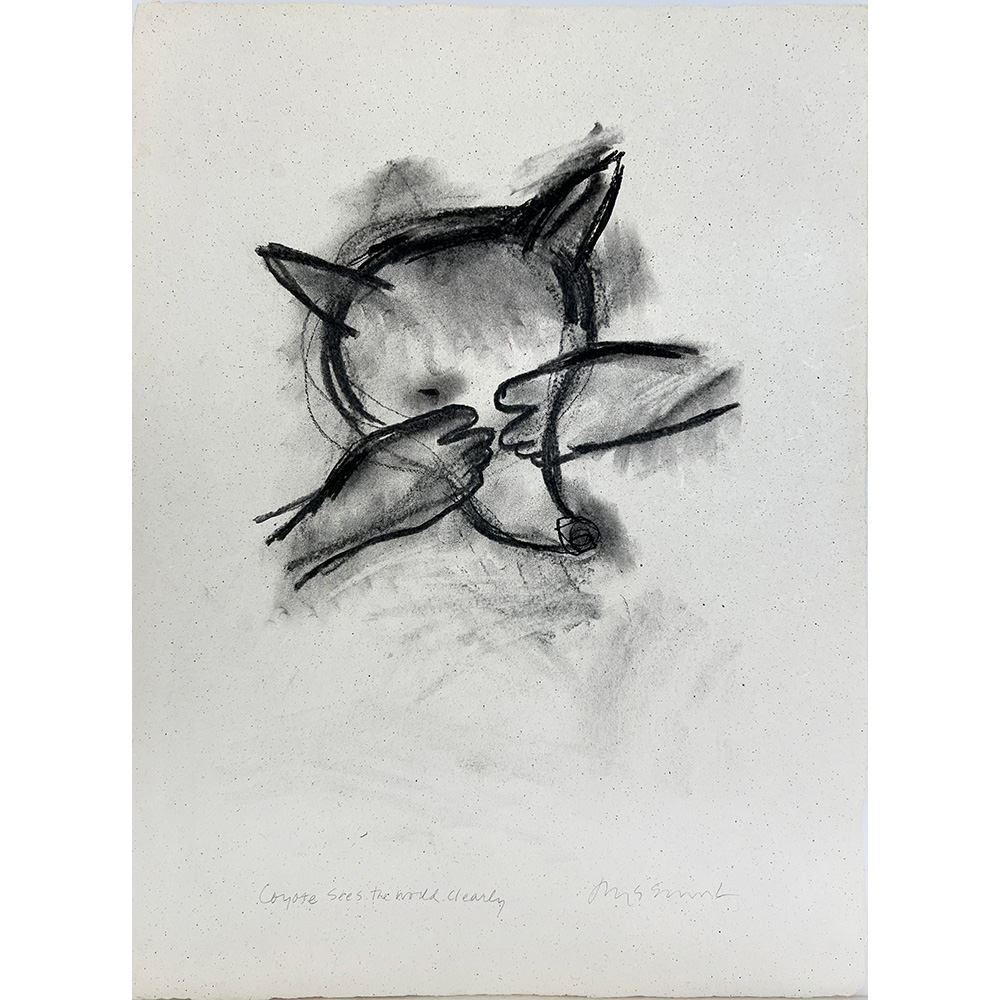Artwork Description
Jaune Quick-to-See Smith – Coyote Sees the World Clearly
Dimensions: 34.5 x 27″ framed / 30 x 22″ unframed
Year: 2009
Medium: charcoal on paper
Jaune Quick-to-See Smith was born at the St. Ignatius Indian Mission on her reservation. She is an enrolled Salish member of the Confederated Salish and Kootenai Nation, Montana. She was fundamental in the development of Institute for American Indian Arts in Santa Fe, and she has become the leading Native American woman artist on the international art scene. Coyote is a special character in Native American culture, and thus appears frequently in Jaune’s work.
Coyote
Quick-to-See Smith creates artworks that allow insight into Native American lived experience, continuing the storytelling traditions of her ancestors. She absorbed the Salish creation stories told by her grandmothers and aunts. In Quick-to-See Smith’s artworks, she incorporates the important role Coyote plays in the creation of the land and Salish spirituality. One of Coyote’s roles was to teach the Salish people about their sacred relationship to the land and all living beings. Another role of Coyote was to reveal the more turbulent side of human impact and relationships. The dual meaning of Coyote as simultaneous sage and trickster is one Quick-to-See Smith embraces at the core of her artistic practice. She says of her use of Coyote in her iconography, “The creator, inventor, satirist must show the flip side of things. They turn things upside down in order to lampoon the immorality or insincerity of politicians, priests, or heads of government or show the human condition.” Coyote tests the bounds of possibility and order in our society.
Jaune received an Associate of Arts Degree at Olympic College in Bremerton Washington. She attended the University of Washington in Seattle, received her BA in Art Education at Framingham State College, MA and a masters degree in art at the University of New Mexico.Jaune Quick-to-See Smith is one of the most acclaimed American Indian artists today. She has been reviewed in most art periodicals. Smith has had over 100 solo exhibits in the past 40 years and has done printmaking projects nationwide. Over that same time, she has organized and/or curated over 30 Native exhibitions, lectured at more than 200 universities, museums and conferences internationally, most recently at 5 universities in China. Smith has completed several collaborative public art works such as the floor design in the Great Hall of the new Denver Airport; an in-situ sculpture piece in Yerba Buena Park, San Francisco and a mile-long sidewalk history trail in West Seattle and recently, a new terrazzo floor design at the Denver Airport.
Smith has received awards such as the Academy of Arts and Letters Purchase Award, NY l987; the Joan Mitchell Foundation Painters Grant 1996; the Women’s Caucus for the Arts Lifetime Achievement 1997; the College Art Association Women’s Award 2002; Governor’s Outstanding New Mexico Woman’s Award 2005; New Mexico Governor’s Award for Excellence in the Arts 2005. Art Table Artist Honoree, NY 2011; Visionary Woman Award 2011, Moore College, Phila. PA; Elected to National Academy of Art, NY 2011; Living Artist of Distinction Award, Georgia O’Keeffe Museum, 2012; Switzer Distinguished Artist 2012; NAEA Ziegfeld Lecture Award 2014; The Woodson Foundation Lifetime Achievement Award 2015 and four honorary doctorates: Minneapolis College of Art and Design 1992; Pennsylvania Academy of Fine Arts 1998; Massachusetts College of Art 2003; University of New Mexico, Albuquerque 2009
She is in the collections of the Museum of Modern Art, Quito, Ecuador; the Museum of Mankind, Vienna, Austria; The Walker, Minneapolis, MN; Smithsonian American Art Museum, Washington DC; the Museum of Modern Art, the Brooklyn Museum, the Metropolitan, The Whitney Museum, NY and the Victoria and Albert Museum, London.
Smith calls herself a cultural arts worker which is also apparent in her work. Elaborating on her Native worldview, Smith’s work addresses today’s tribal politics, human rights and environmental issues with humor. Critic Gerrit Henry, (Art in America 2001) wrote: “For all the primal nature of her origins, Smith adeptly takes on contemporary American society in her paintings, drawings and prints, looking at things Native and national through bifocals of the old and the new, the sacred and the profane, the divine and the witty.”

